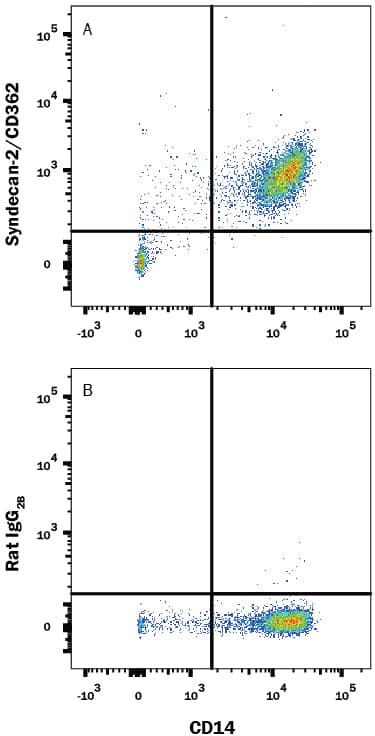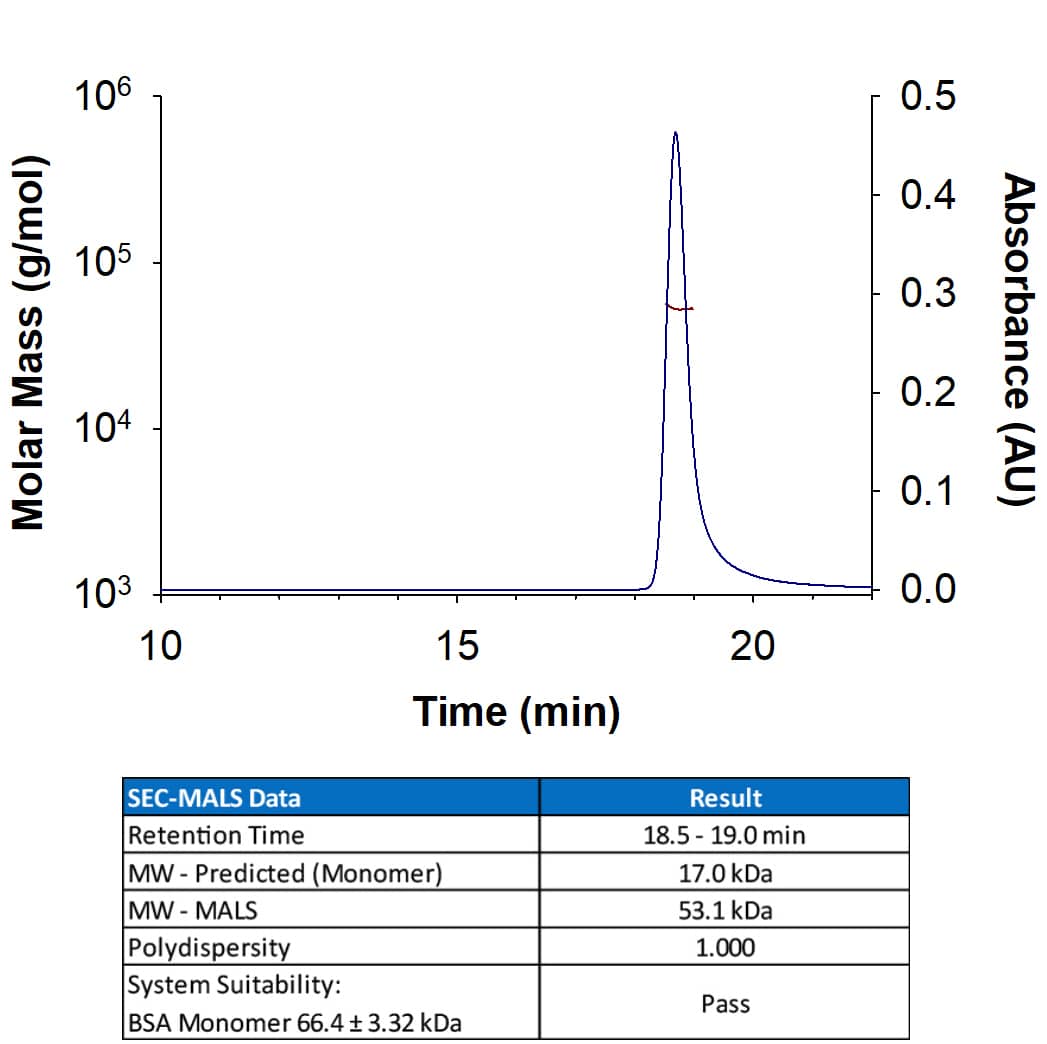Mouse Chemerin Antibody Summary
Thr17-Ser156
Accession # Q9DD06
Customers also Viewed
Applications
Please Note: Optimal dilutions should be determined by each laboratory for each application. General Protocols are available in the Technical Information section on our website.
Scientific Data
 View Larger
View Larger
Chemotaxis Induced by Chemerin and Neutralization by Mouse Chemerin Antibody. Recombinant Mouse Chemerin (2325-CM) chemo-attracts the BaF3 mouse pro-B cell line transfected with human Chem R23 in a dose-dependent manner (orange line). The amount of cells that migrated through to the lower chemotaxis chamber was measured by Resazurin (AR002). Chemotaxis elicited by Recombinant Mouse Chemerin (100 ng/mL) is neutralized (green line) by increasing concentrations of Goat Anti-Mouse Chemerin Antigen Affinity-purified Polyclonal Antibody (Catalog # AF2325). The ND50 is typically 3-9 µg/mL.
Preparation and Storage
- 12 months from date of receipt, -20 to -70 °C as supplied.
- 1 month, 2 to 8 °C under sterile conditions after reconstitution.
- 6 months, -20 to -70 °C under sterile conditions after reconstitution.
Background: Chemerin
Mouse Chemerin, also known as Tazarotene-induced Gene-2 (TIG2), is a new, but distant member of the cystatin superfamily (1-3). Members of this superfamily contain at least two intrachain disulfide bonds and an alpha -helical structure over a distance of about 100 amino acids (2, 3). Chemerin is synthesized as a 162 amino acid (aa) precursor that contains a hydrophobic N-terminal sequence, an intervening 140 aa cystatin-fold containing domain, and a six aa C-terminal prosegment (4-6). Within the cystatin-fold domain there are three intrachain disulfide bonds that contribute to the characteristic fold (4, 7). The precursor molecule is described as undergoing proteolytic processing at both termini by unknown proteases. The N-terminal 16 residue hydrophobic segment is described as being either a signal sequence or a transmembrane (TM) segment for a type II TM protein (5, 8). In either case it gives rise to a soluble proform that undergoes further processing at the C‑terminus (5). In mouse, the C-terminal six residues are cleaved, giving rise to a monomeric, 16 kDa heparin-binding bioactive molecule (aa 17-156) (5-7). A shorter form has been described in human (7). The activity seems to be concentrated in the nine aa’s preceding the prosegment (aa 148-156). Retention of the prosegment blocks activity (4). The 140 aa mature segment is known to bind to the G-protein coupled receptor termed ChemR23 (5, 7). Binding results in macrophage and immature dendritic cell chemotaxis (5). The distribution of this receptor is limited to immune APCs, and it is assumed that Chemerin is an inflammatory molecule. It is unclear which cells are actually producing Chemerin, but keratinocytes, endothelial cells and osteoclasts are potential candidates (1, 7). Mature mouse Chemerin shares 67%, 84%, and 82% aa sequence identity to human, rat, and hamster Chemerin, respectively (6). There is apparently cross-species activity for the protein (6).
- Nagpal, S. et al. (1997) J. Invest. Dermatol. 109:91.
- Storici, P. et al. (1996) Eur. J. Biochem. 238:769.
- Zanetti, M. (2004) J. Leukoc. Biol. 75:39.
- Wittamer, V. et al. (2004) J. Biol. Chem. 279:9956.
- Wittamer, V. et al. (2003) J. Exp. Med. 198:977.
- Busmann, A. et al. (2004) J. Chromatog. B 811:217.
- Meder, W. et al. (2003) FEBS Lett. 555:495.
- Yokoyama-Kobayashi, M. et al. (1999) Gene 228:161.
Product Datasheets
Citations for Mouse Chemerin Antibody
R&D Systems personnel manually curate a database that contains references using R&D Systems products. The data collected includes not only links to publications in PubMed, but also provides information about sample types, species, and experimental conditions.
13
Citations: Showing 1 - 10
Filter your results:
Filter by:
-
Chemerin Isoform-Specific Effects on Hepatocyte Migration and Immune Cell Inflammation
Authors: Susanne Feder, Astrid Bruckmann, Nichole McMullen, Christopher J. Sinal, Christa Buechler
International Journal of Molecular Sciences
-
Chemerin influences blood lipid of aged male mice under high fat diet and exercise states through regulating the distribution and browning of white adipose tissue
Authors: Qu, J;Fu, S;Yin, L;Zhang, Q;Wang, X;
Cytokine
Species: Mouse, Transgenic Mouse
Sample Types: Tissue Homogenates
Applications: Western Blot -
Discovery of chemerin as the new chemoattractant of human mesenchymal stem cells
Authors: I Kim, H Park, I Hwang, D Moon, H Yun, EJ Lee, HS Kim
Cell & bioscience, 2021-07-01;11(1):120.
Species: Mouse
Sample Types: Cell Lysates
Applications: Western Blot -
Astrocytes influence medulloblastoma phenotypes and CD133 surface expression
Authors: E Gronseth, A Gupta, C Koceja, S Kumar, RG Kutty, K Rarick, L Wang, R Ramchandra
PLoS ONE, 2020-07-06;15(7):e0235852.
Species: Zebrafish
Sample Types: Whole Cells
Applications: Western Blot -
Targeting VEGF-A in myeloid cells enhances natural killer cell responses to chemotherapy and ameliorates cachexia
Nat Commun, 2016-08-19;7(0):12528.
Species: Mouse
Sample Types: In Vivo
Applications: Neutralization -
Pro- and Anti-Inflammatory Role of ChemR23 Signaling in Pollutant-Induced Inflammatory Lung Responses.
Authors: Provoost S, De Grove K, Fraser G, Lannoy V, Tournoy K, Brusselle G, Maes T, Joos G
J Immunol, 2016-01-15;196(4):1882-90.
Species: Mouse
Sample Types: Whole Tissue
Applications: IHC-P -
The expression and regulation of chemerin in the epidermis.
Authors: Banas M, Zegar A, Kwitniewski M, Zabieglo K, Marczynska J, Kapinska-Mrowiecka M, LaJevic M, Zabel B, Cichy J
PLoS ONE, 2015-02-06;10(2):e0117830.
Species: Mouse
Sample Types: Tissue Homogenates
Applications: ELISA Development (Capture) -
Chemerin neutralization blocks hematopoietic stem cell osteoclastogenesis.
Authors: Muruganandan S, Dranse H, Rourke J, McMullen N, Sinal C
Stem Cells, 2013-10-01;31(10):2172-82.
Species: Mouse
Sample Types: Cell Lysates
Applications: Western Blot -
Chemerin, a novel peroxisome proliferator-activated receptor gamma (PPARgamma) target gene that promotes mesenchymal stem cell adipogenesis.
Authors: Muruganandan S, Parlee SD, Rourke JL, Ernst MC, Goralski KB, Sinal CJ
J. Biol. Chem., 2011-05-14;286(27):23982-95.
Species: Mouse
Sample Types: Cell Lysates, Whole Cells
Applications: Neutralization, Western Blot -
The Role of ChemR23 in the Induction and Resolution of Cigarette Smoke-Induced Inflammation.
Authors: Demoor T, Bracke KR, Dupont LL
J. Immunol., 2011-03-23;186(9):5457-67.
Species: Mouse
Sample Types: Whole Tissue
Applications: IHC-P -
Chemerin peptides promote phagocytosis in a ChemR23- and Syk-dependent manner.
Authors: Cash JL, Christian AR, Greaves DR
J. Immunol., 2010-04-02;184(9):5315-24.
Species: Mouse
Sample Types: In Vivo
Applications: Neutralization -
Mouse ChemR23 is expressed in dendritic cell subsets and macrophages, and mediates an anti-inflammatory activity of chemerin in a lung disease model.
Authors: Luangsay S, Wittamer V, Bondue B, De Henau O, Rouger L, Brait M, Franssen JD, de Nadai P, Huaux F, Parmentier M
J. Immunol., 2009-10-19;183(10):6489-99.
Species: Mouse
Sample Types: Whole Cells
Applications: ICC -
Expression of Bioactive Chemerin by Keratinocytes Inhibits Late Stages of Tumor Development in a Chemical Model of Skin Carcinogenesis
Authors: Ingrid Dubois-Vedrenne, Olivier De Henau, Virginie Robert, Francina Langa, Joaquim Javary, Diana Al Delbany et al.
Frontiers in Oncology
FAQs
No product specific FAQs exist for this product, however you may
View all Antibody FAQsIsotype Controls
Reconstitution Buffers
Secondary Antibodies
Reviews for Mouse Chemerin Antibody
There are currently no reviews for this product. Be the first to review Mouse Chemerin Antibody and earn rewards!
Have you used Mouse Chemerin Antibody?
Submit a review and receive an Amazon gift card.
$25/€18/£15/$25CAN/¥75 Yuan/¥2500 Yen for a review with an image
$10/€7/£6/$10 CAD/¥70 Yuan/¥1110 Yen for a review without an image















